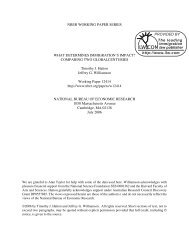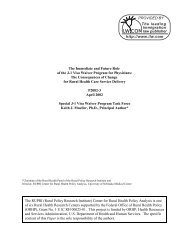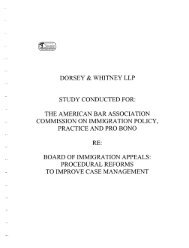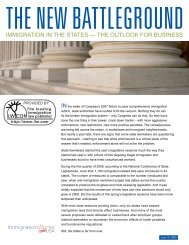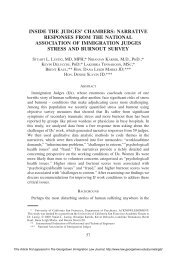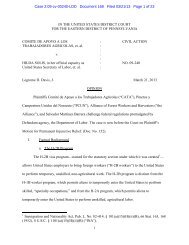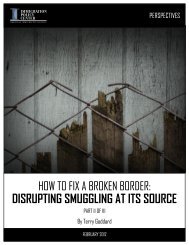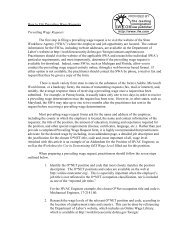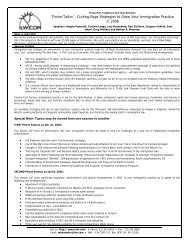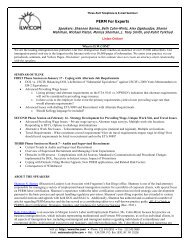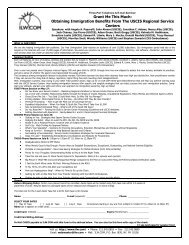The Size and Characteristics of the Unauthorized Migrant ... - ILW.com
The Size and Characteristics of the Unauthorized Migrant ... - ILW.com
The Size and Characteristics of the Unauthorized Migrant ... - ILW.com
Create successful ePaper yourself
Turn your PDF publications into a flip-book with our unique Google optimized e-Paper software.
Research Report<br />
March 7, 2006<br />
<strong>The</strong> <strong>Size</strong> <strong>and</strong> <strong>Characteristics</strong> <strong>of</strong> <strong>the</strong> <strong>Unauthorized</strong><br />
<strong>Migrant</strong> Population in <strong>the</strong> U.S.<br />
Estimates Based on <strong>the</strong> March 2005 Current Population Survey<br />
Jeffrey S. Passel<br />
Senior Research Associate, Pew Hispanic Center<br />
Analysis <strong>of</strong> <strong>the</strong> March 2005 Current Population Survey shows that <strong>the</strong>re were<br />
11.1 million unauthorized in <strong>the</strong> United States a year ago. Based on analysis <strong>of</strong> o<strong>the</strong>r<br />
data sources that <strong>of</strong>fer indications <strong>of</strong> <strong>the</strong> pace <strong>of</strong> growth in <strong>the</strong> foreign-born population,<br />
<strong>the</strong> Center developed an estimate <strong>of</strong> 11.5 to 12 million for <strong>the</strong> unauthorized population as<br />
<strong>of</strong> March 2006.<br />
In <strong>the</strong> March 2005 estimate two-thirds (66%) <strong>of</strong> <strong>the</strong> unauthorized population had been in<br />
<strong>the</strong> country for ten years or less, <strong>and</strong> <strong>the</strong> largest share, 40% <strong>of</strong> <strong>the</strong> total or 4.4 million<br />
people had been in <strong>the</strong> country five years or less. <strong>The</strong>re were 5.4 million adult males in<br />
<strong>the</strong> unauthorized population in 2005, accounting for 49% <strong>of</strong> <strong>the</strong> total. <strong>The</strong>re were 3.9<br />
million adult females accounting for 35% <strong>of</strong> <strong>the</strong> population. <strong>The</strong>re were 1.8 million<br />
children who were unauthorized, 16% <strong>of</strong> <strong>the</strong> total. In addition, <strong>the</strong>re were 3.1 million<br />
children who are U.S. citizens by birth living in families in which <strong>the</strong> head <strong>of</strong> <strong>the</strong> family<br />
or a spouse was unauthorized.<br />
About 7.2 million unauthorized migrants were employed in March 2005, accounting for<br />
about 4.9% <strong>of</strong> <strong>the</strong> civilian labor force. <strong>The</strong>y made up a large share <strong>of</strong> all workers in a few<br />
more detailed occupational categories, including 24% <strong>of</strong> all workers employed in farming<br />
occupations, 17% in cleaning, 14% in construction <strong>and</strong> 12% in food preparation.<br />
About <strong>the</strong> Author: Dr. Jeffrey S. Passel, senior research associate at <strong>the</strong> Pew Hispanic Center, is widely<br />
recognized for his general demographic expertise <strong>and</strong> as one <strong>of</strong> <strong>the</strong> nation’s premier experts on<br />
immigration. In 2005 Dr. Passel was made a fellow <strong>of</strong> <strong>the</strong> American Statistical Association for his<br />
outst<strong>and</strong>ing contributions to <strong>the</strong> measurement <strong>of</strong> population <strong>com</strong>position <strong>and</strong> change. Prior to joining <strong>the</strong><br />
Center in 2005, Dr. Passel was principal research associate at <strong>the</strong> Urban Institute.<br />
About <strong>the</strong> Pew Hispanic Center: Founded in 2001, <strong>the</strong> Pew Hispanic Center is a nonpartisan research<br />
organization supported by <strong>The</strong> Pew Charitable Trusts, a Philadelphia-based charity. <strong>The</strong> Pew Hispanic<br />
Center’s mission is to improve underst<strong>and</strong>ing <strong>of</strong> <strong>the</strong> diverse Hispanic population <strong>and</strong> to chronicle Latinos'<br />
growing impact on <strong>the</strong> nation. <strong>The</strong> Pew Hispanic Center is a project <strong>of</strong> <strong>the</strong> Pew Research Center, a<br />
nonpartisan "fact tank" in Washington, DC, that provides information on <strong>the</strong> issues, attitudes, <strong>and</strong> trends<br />
shaping America <strong>and</strong> <strong>the</strong> world; it does not advocate for or take positions on policy issues.<br />
Pew Hispanic Center<br />
A Pew Research Center Project<br />
1615 L Street, NW, Suite 700 • Washington, DC 20036-5610 • Phone: 202-419-3600 • Fax: 202-419-3608<br />
www.pewhispanic.org<br />
© 2006 Pew Hispanic Center, a Pew Research Center project, www.pewhispanic.org
© 2006 Pew Hispanic Center, a Pew Research Center project, www.pewhispanic.org<br />
<strong>Size</strong> <strong>and</strong> <strong>Characteristics</strong> <strong>of</strong> <strong>the</strong> <strong>Unauthorized</strong> <strong>Migrant</strong> Population<br />
Estimates Based on <strong>the</strong> March 2005 Current Population Survey<br />
Page i<br />
Executive Summary<br />
<strong>The</strong> Pew Hispanic Center estimates that <strong>the</strong>re are currently 11.5 to 12 million<br />
unauthorized migrants living in <strong>the</strong> United States.<br />
This estimate is based on data from Census 2000, <strong>the</strong> March 2005 Current<br />
Population Survey (CPS) <strong>and</strong> <strong>the</strong> monthly Current Population Surveys through January<br />
2006. Analysis <strong>of</strong> <strong>the</strong> March 2005 CPS shows that <strong>the</strong>re were 11.1 million unauthorized<br />
in <strong>the</strong> United States a year ago. Based on <strong>the</strong> monthly Current Population Surveys<br />
conducted since <strong>the</strong>n <strong>and</strong> o<strong>the</strong>r data sources that <strong>of</strong>fer indications <strong>of</strong> <strong>the</strong> pace <strong>of</strong> growth in<br />
<strong>the</strong> foreign-born population, <strong>the</strong> Center developed an estimate <strong>of</strong> 11.5 to 12 million for<br />
<strong>the</strong> unauthorized population as <strong>of</strong> March 2006. See “Note on Methods <strong>and</strong> Terminology”<br />
below for definitions, data sources,<br />
<strong>and</strong> methods.<br />
<strong>Unauthorized</strong> <strong>Migrant</strong>s<br />
Using a well-established<br />
methodology, this report <strong>of</strong>fers<br />
estimates for <strong>the</strong> size <strong>and</strong> certain<br />
characteristics, such as age <strong>and</strong><br />
national origins, <strong>of</strong> <strong>the</strong> unauthorized<br />
population. Major findings include:<br />
Numbers <strong>and</strong> Origins<br />
• <strong>The</strong> number <strong>of</strong> unauthorized<br />
migrants living in <strong>the</strong><br />
United States has<br />
continued to increase<br />
steadily for several years,<br />
reaching an estimated<br />
11.1 million based on <strong>the</strong><br />
March 2005 <strong>com</strong>pared to<br />
an estimate <strong>of</strong> 8.4 million<br />
based on Census 2000.<br />
This report uses <strong>the</strong> term “unauthorized migrant” to<br />
mean a person who resides in <strong>the</strong> United States but who is<br />
not a U.S. citizen, has not been admitted for permanent<br />
residence, <strong>and</strong> is not in a set <strong>of</strong> specific authorized temporary<br />
statuses permitting longer-term residence <strong>and</strong> work. (See<br />
Passel, Van Hook, <strong>and</strong> Bean 2004 for fur<strong>the</strong>r discussion.)<br />
Two groups account for <strong>the</strong> vast majority <strong>of</strong> this<br />
population: (a) those who entered <strong>the</strong> country without valid<br />
documents, including people crossing <strong>the</strong> Southwestern<br />
border cl<strong>and</strong>estinely; <strong>and</strong> (b) those who entered with valid<br />
visas but overstayed <strong>the</strong>ir visas’ expiration or o<strong>the</strong>rwise<br />
violated <strong>the</strong> terms <strong>of</strong> <strong>the</strong>ir admission. Some migrants in this<br />
estimate have legal authorization to live <strong>and</strong> work in <strong>the</strong><br />
United States on a temporary basis. <strong>The</strong>se include migrants<br />
with temporary protected status (TPS) <strong>and</strong> some migrants<br />
with unresolved asylum claims. Toge<strong>the</strong>r <strong>the</strong>y may account<br />
for as much as 10% <strong>of</strong> <strong>the</strong> estimate.<br />
• Since 2000, growth in <strong>the</strong> unauthorized population has averaged more than<br />
500,000 per year. Based on evidence that this trend has persisted, <strong>the</strong> current<br />
unauthorized population can be estimated at between 11.5 <strong>and</strong> 12 million.<br />
• In <strong>the</strong> March 2005 estimate two-thirds (66%) <strong>of</strong> <strong>the</strong> unauthorized population had<br />
been in <strong>the</strong> country for ten years or less, <strong>and</strong> <strong>the</strong> largest share, 40% <strong>of</strong> <strong>the</strong> total<br />
or 4.4 million people had been in <strong>the</strong> country five years or less.<br />
• <strong>Unauthorized</strong> migrants accounted for 30% <strong>of</strong> <strong>the</strong> foreign-born population in 2005.<br />
Ano<strong>the</strong>r 28% were legal permanent residents, <strong>and</strong> 31% were U.S. citizens by<br />
naturalization.<br />
• Most <strong>of</strong> unauthorized migrants came from Mexico. <strong>The</strong>re were an estimated<br />
6.2 million unauthorized Mexican migrants in 2005, or 56% <strong>of</strong> <strong>the</strong><br />
unauthorized population.<br />
Pew Hispanic Center March 7, 2006
© 2006 Pew Hispanic Center, a Pew Research Center project, www.pewhispanic.org<br />
<strong>Size</strong> <strong>and</strong> <strong>Characteristics</strong> <strong>of</strong> <strong>the</strong> <strong>Unauthorized</strong> <strong>Migrant</strong> Population<br />
Estimates Based on <strong>the</strong> March 2005 Current Population Survey<br />
Page ii<br />
• About 2.5 million unauthorized migrants, or 22% <strong>of</strong> <strong>the</strong> total, have <strong>com</strong>e from <strong>the</strong><br />
rest <strong>of</strong> Latin America, primarily from Central America. <strong>Unauthorized</strong><br />
migrants from Mexico <strong>and</strong> <strong>the</strong> rest <strong>of</strong> Latin America represented 78% <strong>of</strong> <strong>the</strong><br />
unauthorized population in 2005.<br />
• Between 2000 <strong>and</strong> 2005 <strong>the</strong> number <strong>of</strong> unauthorized migrants from Mexico<br />
increased by about 1.5 million. O<strong>the</strong>r large increases occurred among<br />
unauthorized migrants from Central America (+465,000) <strong>and</strong> South <strong>and</strong> East<br />
Asia (+365,000).<br />
Family <strong>Characteristics</strong><br />
• <strong>The</strong>re were 5.4 million adult males in <strong>the</strong> unauthorized population in 2005,<br />
accounting for 49% <strong>of</strong> <strong>the</strong> total. <strong>The</strong>re were 3.9 million adult females<br />
accounting for 35% <strong>of</strong> <strong>the</strong> population. In addition, <strong>the</strong>re were 1.8 million<br />
children in <strong>the</strong> unauthorized population, or 16% <strong>of</strong> <strong>the</strong> total.<br />
• Among adults, males make up 58% <strong>of</strong> <strong>the</strong> unauthorized population while females<br />
make up 42%.<br />
• As <strong>of</strong> 2005, <strong>the</strong>re were 6.6 million families in which ei<strong>the</strong>r <strong>the</strong> head <strong>of</strong> <strong>the</strong> family<br />
or <strong>the</strong> spouse was unauthorized. <strong>The</strong>se unauthorized families contained<br />
14.6 million persons.<br />
• Nearly two-thirds (64%) <strong>of</strong> <strong>the</strong> children living in unauthorized families are<br />
U.S. citizens by birth, an estimated 3.1 million children in 2005.<br />
Labor Force <strong>Characteristics</strong><br />
• <strong>Unauthorized</strong> migrants accounted for about 4.9% <strong>of</strong> <strong>the</strong> civilian labor force in<br />
March 2005, or about 7.2 million workers out <strong>of</strong> a labor force <strong>of</strong> 148 million.<br />
• <strong>Unauthorized</strong> workers are employed in a variety <strong>of</strong> occupations, although <strong>the</strong><br />
distribution <strong>of</strong> <strong>the</strong> unauthorized workforce across occupations differs from<br />
that <strong>of</strong> native-born workers. For example, nearly a third (31%) <strong>of</strong><br />
unauthorized workers were employed in service occupations <strong>com</strong>pared to onesixth<br />
(16%) <strong>of</strong> native workers in March 2005. <strong>Unauthorized</strong> migrants are<br />
underrepresented in white-collar occupations.<br />
• About 19% <strong>of</strong> unauthorized workers were employed in construction <strong>and</strong><br />
extractive occupations, 15% in production, installation <strong>and</strong> repair <strong>and</strong> 4% in<br />
farming.<br />
• <strong>Unauthorized</strong> migrants make up a large share <strong>of</strong> all workers in a few more<br />
detailed occupational categories. <strong>The</strong>y were 24% <strong>of</strong> all workers employed in<br />
farming occupations, 17% in cleaning, 14% in construction <strong>and</strong> 12% in food<br />
preparation industries. Within those categories, unauthorized workers were a<br />
very large share <strong>of</strong> all workers in certain specific occupations. For example,<br />
Pew Hispanic Center March 7, 2006
© 2006 Pew Hispanic Center, a Pew Research Center project, www.pewhispanic.org<br />
<strong>Size</strong> <strong>and</strong> <strong>Characteristics</strong> <strong>of</strong> <strong>the</strong> <strong>Unauthorized</strong> <strong>Migrant</strong> Population<br />
Estimates Based on <strong>the</strong> March 2005 Current Population Survey<br />
Page iii<br />
<strong>the</strong> unauthorized were 36% <strong>of</strong> all insulation workers <strong>and</strong> 29% <strong>of</strong> all ro<strong>of</strong>ers<br />
<strong>and</strong> drywall installers, 27% <strong>of</strong> all butchers <strong>and</strong> o<strong>the</strong>r food processing workers.<br />
• <strong>The</strong> concentration <strong>of</strong> unauthorized workers in broad industries is not as marked as<br />
<strong>the</strong> concentration in broad occupation groups. Only in “leisure & hospitality”<br />
<strong>and</strong> in “construction” does <strong>the</strong> share <strong>of</strong> unauthorized workers greatly exceed<br />
<strong>the</strong> share <strong>of</strong> natives. About 1 in 5 unauthorized workers was in <strong>the</strong><br />
construction industry (20%) <strong>and</strong> 1 in 6 was in <strong>the</strong> leisure & hospitality<br />
industry (17%). Only about 7%–8% <strong>of</strong> native workers was in each <strong>of</strong> <strong>the</strong>se<br />
industries.<br />
• <strong>The</strong>re are a few detailed industries with high concentrations <strong>and</strong> significant<br />
numbers <strong>of</strong> unauthorized workers. <strong>The</strong> unauthorized were 21% <strong>of</strong> <strong>the</strong><br />
workers in private household industries. <strong>The</strong>y were between 12% <strong>and</strong> 14% <strong>of</strong><br />
all <strong>the</strong> workers in food manufacturing, farming, furniture manufacturing,<br />
construction, textiles, <strong>and</strong> food services.<br />
Pew Hispanic Center March 7, 2006
© 2006 Pew Hispanic Center, a Pew Research Center project, www.pewhispanic.org<br />
<strong>Size</strong> <strong>and</strong> <strong>Characteristics</strong> <strong>of</strong> <strong>the</strong> <strong>Unauthorized</strong> <strong>Migrant</strong> Population<br />
Estimates Based on <strong>the</strong> March 2005 Current Population Survey<br />
Table <strong>of</strong> Contents<br />
Executive Summary.............................................................................................i<br />
Numbers <strong>and</strong> Origins ................................................................................................................i<br />
Family <strong>Characteristics</strong>..............................................................................................................ii<br />
Labor Force <strong>Characteristics</strong>.....................................................................................................ii<br />
Part 1 — <strong>Unauthorized</strong> <strong>Migrant</strong>s: <strong>The</strong> Numbers...............................................1<br />
How <strong>the</strong> estimates are formulated .......................................................................................... 1<br />
Current estimates.................................................................................................................... 1<br />
Most unauthorized migrants arrived in <strong>the</strong> past decade......................................................... 2<br />
<strong>The</strong> unauthorized are 30% <strong>of</strong> <strong>the</strong> foreign born population ..................................................... 3<br />
National origins: Mexico dominates <strong>the</strong> flow........................................................................... 4<br />
Part 2 — <strong>Unauthorized</strong> <strong>Migrant</strong>s: Families <strong>and</strong> Children ................................6<br />
Gender <strong>and</strong> family <strong>com</strong>position .............................................................................................. 6<br />
Families with children.............................................................................................................. 8<br />
Part 3 — <strong>Unauthorized</strong> <strong>Migrant</strong>s: <strong>The</strong> Workforce ............................................9<br />
High levels <strong>of</strong> employment for men but not for women........................................................... 9<br />
Occupations .......................................................................................................................... 10<br />
Industries............................................................................................................................... 13<br />
Note on Methods <strong>and</strong> Terminology .................................................................14<br />
Getting <strong>the</strong> Number............................................................................................................... 14<br />
Who is Legal ......................................................................................................................... 15<br />
Who is <strong>Unauthorized</strong>.............................................................................................................16<br />
Augmentation <strong>of</strong> <strong>the</strong> CPS ..................................................................................................... 17<br />
References ........................................................................................................17<br />
Figures<br />
Figure 1. <strong>Unauthorized</strong> <strong>Migrant</strong>s by Period <strong>of</strong> Arrival: March 2005 ................................2<br />
Figure 2. Trend in <strong>Unauthorized</strong> <strong>Migrant</strong>s Living in <strong>the</strong> United States: 1980–2005........3<br />
Figure 3. Legal Status <strong>of</strong> Foreign-Born Population: March 2005 ....................................4<br />
Figure 4. Country <strong>of</strong> Birth <strong>of</strong> <strong>the</strong> <strong>Unauthorized</strong> <strong>Migrant</strong> Population: March 2005............5<br />
Figure 5. <strong>Unauthorized</strong> <strong>Migrant</strong> Population by Region <strong>of</strong> Birth: March 2005 ..................6<br />
Figure 6. Demographic Composition <strong>of</strong> <strong>Unauthorized</strong> Families: March 2005.................7<br />
Figure 7. <strong>Unauthorized</strong> Families Classified by Composition: March 2005......................8<br />
Figure 8. Labor Force Participation Rate by Gender, Nativity, <strong>and</strong> Legal Status:<br />
March 2005 .....................................................................................................9<br />
Figure 9. Distribution <strong>of</strong> <strong>Unauthorized</strong> Workers by Major Occupation Group:<br />
March 2005 ...................................................................................................10<br />
Figure 10. Proportion <strong>of</strong> Workers who are <strong>Unauthorized</strong> for Selected Detailed<br />
Occupation Groups: March 2005..................................................................11<br />
Figure 11. Distribution <strong>of</strong> <strong>Unauthorized</strong> Workers by Major Industry: March 2005.........13<br />
Figure 12. Proportion <strong>of</strong> Workers who are <strong>Unauthorized</strong> for Selected Detailed<br />
Industries: March 2005.................................................................................14<br />
Table<br />
Table 1. <strong>Unauthorized</strong> <strong>Migrant</strong> Share <strong>of</strong> Selected Specific Occupations: March 2005.12<br />
Pew Hispanic Center March 7, 2006
© 2006 Pew Hispanic Center, a Pew Research Center project, www.pewhispanic.org<br />
<strong>Size</strong> <strong>and</strong> <strong>Characteristics</strong> <strong>of</strong> <strong>the</strong> <strong>Unauthorized</strong> <strong>Migrant</strong> Population Page 1<br />
Estimates Based on <strong>the</strong> March 2005 Current Population Survey<br />
Part 1 — <strong>Unauthorized</strong> <strong>Migrant</strong>s: <strong>The</strong> Numbers<br />
How <strong>the</strong> estimates are formulated<br />
Nei<strong>the</strong>r <strong>the</strong> Census Bureau nor any o<strong>the</strong>r U.S. government agency counts <strong>the</strong><br />
unauthorized migrant population or defines its demographic characteristics based on<br />
specific enumeration. <strong>The</strong> “residual method” is, however, a widely-accepted<br />
methodology for estimating <strong>the</strong> size <strong>and</strong> certain characteristics, such as age <strong>and</strong> national<br />
origins, <strong>of</strong> <strong>the</strong> undocumented population based on <strong>of</strong>ficial data. This methodology<br />
essentially subtracts <strong>the</strong> estimated legal-immigrant population from <strong>the</strong> total foreign-born<br />
population <strong>and</strong> treats <strong>the</strong> residual as a source <strong>of</strong> data on <strong>the</strong> unauthorized migrant<br />
population (Passel, Van Hook, <strong>and</strong> Bean 2004).<br />
<strong>The</strong> estimates reported here are based on this methodology applied to data from<br />
<strong>the</strong> March 2005 Current Population Survey (CPS). <strong>The</strong> CPS, a monthly survey <strong>of</strong> about<br />
50,000 households conducted jointly by <strong>the</strong> U.S. Bureau <strong>of</strong> Labor Statistics <strong>and</strong> <strong>the</strong><br />
Census Bureau, is best known as <strong>the</strong> source for monthly unemployment statistics. Every<br />
March both <strong>the</strong> sample size <strong>and</strong> <strong>the</strong> questionnaire <strong>of</strong> <strong>the</strong> CPS are augmented to produce<br />
<strong>the</strong> Annual Social <strong>and</strong> Economic Supplement, which provides additional data on several<br />
additional subjects, including <strong>the</strong> foreign-born population. See “Note on Methods <strong>and</strong><br />
Terminology” below for definitions, data sources, <strong>and</strong> methods. A report based on data<br />
from <strong>the</strong> March 2004 CPS was published by <strong>the</strong> Center on June 14, 2005 <strong>and</strong> can be<br />
accessed at <strong>the</strong> following link: <strong>Unauthorized</strong> <strong>Migrant</strong>s: Numbers <strong>and</strong> <strong>Characteristics</strong><br />
This methodology uses <strong>the</strong> term “unauthorized migrant” to mean a person who<br />
resides in <strong>the</strong> United States, but who is not a U.S. citizen, has not been admitted for<br />
permanent residence, <strong>and</strong> is not in a set <strong>of</strong> specific authorized temporary statuses<br />
permitting longer-term residence <strong>and</strong> work. (See Passel, Van Hook, <strong>and</strong> Bean 2004 for<br />
fur<strong>the</strong>r discussion.) Two groups account for <strong>the</strong> vast majority <strong>of</strong> this population:<br />
(a) those who entered <strong>the</strong> country without valid documents, including people crossing <strong>the</strong><br />
Southwestern border cl<strong>and</strong>estinely; <strong>and</strong> (b) those who entered with valid visas but<br />
overstayed <strong>the</strong>ir visas’ expiration or o<strong>the</strong>rwise violated <strong>the</strong> terms <strong>of</strong> <strong>the</strong>ir admission.<br />
Some individuals in our estimated unauthorized migrant population initially belonged to<br />
one <strong>of</strong> <strong>the</strong>se groups but have obtained a temporary legal authorization to live <strong>and</strong> work in<br />
<strong>the</strong> United States. <strong>The</strong>se individuals, many <strong>of</strong> whom are likely to revert to an<br />
unauthorized status, include migrants with temporary protected status (TPS) <strong>and</strong> o<strong>the</strong>rs<br />
with unresolved asylum claims. Toge<strong>the</strong>r <strong>the</strong>y may account for as much as 10% <strong>of</strong> <strong>the</strong><br />
estimate. In assessing potential programs for dealing with <strong>the</strong> unauthorized population, it<br />
seems appropriate to treat <strong>the</strong> quasi-legal group as part <strong>of</strong> <strong>the</strong> unauthorized program since<br />
a significant share <strong>of</strong> this group would probably be eligible to participate in any program<br />
that might lead to regularization <strong>of</strong> <strong>the</strong>ir status, such as a temporary worker program or an<br />
earned legalization program. (For an opposite view, see Martin 2005.)<br />
Current estimates<br />
As <strong>of</strong> March 2005, <strong>the</strong>re were an estimated 11.1 million unauthorized migrants<br />
living in <strong>the</strong> United States. A <strong>com</strong>parison to past estimates derived with <strong>the</strong> same<br />
Pew Hispanic Center March 7, 2006
© 2006 Pew Hispanic Center, a Pew Research Center project, www.pewhispanic.org<br />
<strong>Size</strong> <strong>and</strong> <strong>Characteristics</strong> <strong>of</strong> <strong>the</strong> <strong>Unauthorized</strong> <strong>Migrant</strong> Population Page 2<br />
Estimates Based on <strong>the</strong> March 2005 Current Population Survey<br />
methodology shows that <strong>the</strong> undocumented population has grown rapidly in recent years.<br />
<strong>The</strong>re were 8.4 million unauthorized migrants living in <strong>the</strong> United States in April 2000<br />
according to estimates derived from Census 2000 (Passel, Van Hook, <strong>and</strong> Bean 2004).<br />
Thus, average annual growth over <strong>the</strong> 5-year period since 2000 was more than 500,000<br />
per year. This number reflects <strong>the</strong> number <strong>of</strong> new unauthorized migrants arriving minus<br />
those who ei<strong>the</strong>r die, return to <strong>the</strong>ir country <strong>of</strong> origin, or gain legal status. Data from <strong>the</strong><br />
monthly Current Population Surveys conducted since March 2005, as well as o<strong>the</strong>r<br />
evidence such as <strong>the</strong> number <strong>of</strong> apprehensions by <strong>the</strong> Border Patrol, indicate that <strong>the</strong><br />
unauthorized flow is continuing. Assuming that <strong>the</strong> rate <strong>of</strong> growth evident between<br />
Census 2000 <strong>and</strong> <strong>the</strong> March 2005 CPS held steady, <strong>the</strong> best estimate for March 2006 is<br />
between 11.5 million <strong>and</strong> 12 million for <strong>the</strong> current number <strong>of</strong> unauthorized migrants.<br />
Most unauthorized migrants arrived in <strong>the</strong> past decade<br />
More than 40% <strong>of</strong> <strong>the</strong> unauthorized population in 2005 or 4.4 million persons had<br />
been in <strong>the</strong> country since 2000 (Figure 1). Ano<strong>the</strong>r 26% or 2.9 million people in <strong>the</strong><br />
2005 estimate arrived in <strong>the</strong> 5 years before that. Thus, about two-thirds <strong>of</strong> unauthorized<br />
migrants have been in <strong>the</strong> country less than 10 years.<br />
Most <strong>Unauthorized</strong><br />
Arrived Since 1990<br />
2000-05<br />
4.4 million – 40%<br />
(850,000 per year)<br />
1980s<br />
1.8 million -- 24%<br />
(180,000 per year)<br />
1995-1999<br />
2.9 million -- 26%<br />
(575,000 per year)<br />
1990-94<br />
2.0 million -- 18%<br />
(400,000 per year)<br />
11.1 Million in March 2005<br />
Figure 1. <strong>Unauthorized</strong> <strong>Migrant</strong>s by Period <strong>of</strong> Arrival: March 2005<br />
Source: Pew Hispanic Center tabulations <strong>of</strong> augmented March 2005 Current Population<br />
Survey, adjusted for omissions. See Passel, Van Hook, <strong>and</strong> Bean 2006 for<br />
discussion <strong>of</strong> methodology.<br />
<strong>The</strong> March 2005 estimates are consistent with earlier findings which show that <strong>the</strong><br />
pace <strong>of</strong> <strong>the</strong> unauthorized arrivals accelerated at <strong>the</strong> end <strong>of</strong> <strong>the</strong> 1990s <strong>and</strong> <strong>the</strong> early years<br />
<strong>of</strong> this decade (Passel <strong>and</strong> Suro 2005). Between 2000 <strong>and</strong> 2005 <strong>the</strong> number <strong>of</strong> new<br />
Pew Hispanic Center March 7, 2006
© 2006 Pew Hispanic Center, a Pew Research Center project, www.pewhispanic.org<br />
<strong>Size</strong> <strong>and</strong> <strong>Characteristics</strong> <strong>of</strong> <strong>the</strong> <strong>Unauthorized</strong> <strong>Migrant</strong> Population Page 3<br />
Estimates Based on <strong>the</strong> March 2005 Current Population Survey<br />
arrivals averaged 850,000 a year. Note that this number is higher than <strong>the</strong> annual net<br />
increase to <strong>the</strong> population because it only measures <strong>the</strong> number <strong>of</strong> unauthorized migrants<br />
being added to <strong>the</strong> population <strong>and</strong> does not subtract <strong>the</strong> number who ei<strong>the</strong>r die, return<br />
home or gain legal status.<br />
<strong>Unauthorized</strong> Clearly at<br />
New High — Trend Uncertain<br />
Millions <strong>of</strong> <strong>Unauthorized</strong> <strong>Migrant</strong>s Living in <strong>the</strong> U.S.<br />
8.4<br />
11.1<br />
(2005)<br />
3 3.3<br />
4<br />
2.5<br />
3.9<br />
5<br />
4-80 1-82 6-86 6-89 10-92 10-96 4-00 3-05<br />
Figure 2. Trend in <strong>Unauthorized</strong> <strong>Migrant</strong>s Living in <strong>the</strong> United States:<br />
1980–2005<br />
Source: Developed from a variety <strong>of</strong> previously published estimates. See “References”<br />
below.<br />
<strong>The</strong> unauthorized are 30% <strong>of</strong> <strong>the</strong> foreign born population<br />
<strong>The</strong> foreign-born population totaled 37 million in <strong>the</strong> March 2005 estimates,<br />
including: 11.5 million naturalized citizens (31%), 10.5 million legal permanent resident<br />
(LPR) aliens (28%), 2.6 million refugees (7%) <strong>and</strong> 1.3 million temporary legal migrants<br />
such as students <strong>and</strong> temporary workers (3%). <strong>The</strong> rest <strong>of</strong> <strong>the</strong> foreign-born population<br />
11.1 million or 30% are unauthorized migrants.<br />
[Note that some <strong>of</strong> <strong>the</strong> 2.6 million refugees have naturalized. If <strong>the</strong> refugees are<br />
grouped with LPRs <strong>and</strong> naturalized citizens, LPRs represent 11.8 million or 32% <strong>of</strong> all<br />
immigrants <strong>and</strong> naturalized citizens account for 12.8 million or 35%.]<br />
Pew Hispanic Center March 7, 2006
© 2006 Pew Hispanic Center, a Pew Research Center project, www.pewhispanic.org<br />
<strong>Size</strong> <strong>and</strong> <strong>Characteristics</strong> <strong>of</strong> <strong>the</strong> <strong>Unauthorized</strong> <strong>Migrant</strong> Population Page 4<br />
Estimates Based on <strong>the</strong> March 2005 Current Population Survey<br />
Legal Status <strong>of</strong> Immigrants<br />
Legal Permanent<br />
Resident (LPR)<br />
Aliens<br />
(10.5 million) 28%<br />
<strong>Unauthorized</strong><br />
<strong>Migrant</strong>s<br />
(11.1 million) 30%<br />
Naturalized<br />
Citizens (former LPRs)<br />
(11.5 million) 31%<br />
Temporary Legal<br />
Residents<br />
(1.3 million) 3%<br />
Refugee Arrivals--<br />
(Post-’80)<br />
(2.6 million) 7%<br />
37.0 Million Foreign-Born in 2005<br />
Figure 3. Legal Status <strong>of</strong> Foreign-Born Population: March 2005<br />
Source <strong>and</strong> Notes: Pew Hispanic Center tabulations <strong>of</strong> augmented March 2005 Current<br />
Population Survey, adjusted for omissions. Note that <strong>the</strong> temporary legal<br />
migrant population shown in this figure includes an adjustment for CPS<br />
omissions that is not built into <strong>the</strong> o<strong>the</strong>r tabulations. Thus, <strong>the</strong> foreign-born<br />
population shown here is slightly larger than in o<strong>the</strong>r figures. See Passel, Van<br />
Hook, <strong>and</strong> Bean 2006 for discussion <strong>of</strong> methodology.<br />
National origins: Mexico dominates <strong>the</strong> flow<br />
Most unauthorized migrants <strong>com</strong>e from Mexico. <strong>The</strong>re were 6.2 million<br />
unauthorized migrants from Mexico in 2005, or 56% <strong>of</strong> <strong>the</strong> total, according to <strong>the</strong><br />
CPS-based estimates (Figure 4). <strong>The</strong> Mexican-born population in <strong>the</strong> United States,<br />
including both legal <strong>and</strong> unauthorized migrants, has grown by about 500,000 people a<br />
year for <strong>the</strong> past decade. Of <strong>the</strong> Mexican migrants in <strong>the</strong> U.S. less than 10 years, <strong>the</strong> Pew<br />
Hispanic Center estimates that approximately 80 to 85% are unauthorized.<br />
About 2.5 million unauthorized migrants had <strong>com</strong>e from <strong>the</strong> rest <strong>of</strong> Latin America<br />
in 2005, with most <strong>of</strong> those from Central America. Taken toge<strong>the</strong>r, unauthorized<br />
migrants from Mexico <strong>and</strong> Latin America represented 78% <strong>of</strong> <strong>the</strong> unauthorized<br />
population in 2005. <strong>The</strong>re were about 1.5 million unauthorized migrants from <strong>the</strong> Asian<br />
continent in 2005, representing about 13% <strong>of</strong> <strong>the</strong> total. Europe <strong>and</strong> Canada accounted for<br />
600,000, or 6%, <strong>and</strong> Africa <strong>and</strong> o<strong>the</strong>r countries for about 400,000, or 3%.<br />
Pew Hispanic Center March 7, 2006
© 2006 Pew Hispanic Center, a Pew Research Center project, www.pewhispanic.org<br />
<strong>Size</strong> <strong>and</strong> <strong>Characteristics</strong> <strong>of</strong> <strong>the</strong> <strong>Unauthorized</strong> <strong>Migrant</strong> Population Page 5<br />
Estimates Based on <strong>the</strong> March 2005 Current Population Survey<br />
<strong>Unauthorized</strong> Are<br />
Largely Latin American<br />
O<strong>the</strong>r<br />
Latin America -- 22%<br />
2.5 million<br />
Mexico -- 56%<br />
6.2 million<br />
Asia -- 13%<br />
1.5 million<br />
Europe &<br />
Canada -- 6%<br />
0.6 million<br />
Africa & O<strong>the</strong>r -- 3%<br />
0.4 million<br />
11.1 Million in March 2005<br />
Figure 4. Country <strong>of</strong> Birth <strong>of</strong> <strong>the</strong> <strong>Unauthorized</strong> <strong>Migrant</strong> Population:<br />
March 2005<br />
Source: Pew Hispanic Center tabulations <strong>of</strong> augmented March 2005 Current Population<br />
Survey, adjusted for omissions.<br />
While <strong>the</strong> shares from different regions have hardly changed in <strong>the</strong> last few years,<br />
between 2000 <strong>and</strong> 2005, <strong>the</strong> number <strong>of</strong> unauthorized Mexicans increased by 1.5 million,<br />
from 4.7 million to 6.2 million (Figure 5). During <strong>the</strong> same time period, <strong>the</strong> number <strong>of</strong><br />
unauthorized migrants from Central America increased by 465,000, to 1.4 million; those<br />
from South <strong>and</strong> East Asia by 365,000, to 1.4 million; <strong>and</strong> those from South American by<br />
160,000, to 705,000.<br />
Pew Hispanic Center March 7, 2006
© 2006 Pew Hispanic Center, a Pew Research Center project, www.pewhispanic.org<br />
<strong>Size</strong> <strong>and</strong> <strong>Characteristics</strong> <strong>of</strong> <strong>the</strong> <strong>Unauthorized</strong> <strong>Migrant</strong> Population Page 6<br />
Estimates Based on <strong>the</strong> March 2005 Current Population Survey<br />
6,180<br />
Mexican & Latin American<br />
<strong>Unauthorized</strong> Increase<br />
<strong>Unauthorized</strong> <strong>Migrant</strong><br />
Population (in thous<strong>and</strong>s)<br />
4,701<br />
2000 Census (8.4 million)<br />
2005 CPS (11.1 million)<br />
897<br />
1,363<br />
705<br />
409 406 545 528<br />
630<br />
114<br />
144<br />
1,371<br />
1,008<br />
176 327<br />
Mexico<br />
Central<br />
America<br />
Caribbean<br />
South<br />
America<br />
Europe &<br />
Canada<br />
Middle East<br />
(Afr. & Asia)<br />
South &<br />
East Asia<br />
All O<strong>the</strong>r<br />
Figure 5. <strong>Unauthorized</strong> <strong>Migrant</strong> Population by Region <strong>of</strong> Birth:<br />
March 2005<br />
Source: Pew Hispanic Center tabulations <strong>of</strong> augmented March 2005 Current Population<br />
Survey <strong>and</strong> Census 2000 5-Percent Public-Use Microdata Sample (PUMS), both<br />
adjusted for omissions.<br />
Part 2 — <strong>Unauthorized</strong> <strong>Migrant</strong>s: Families <strong>and</strong> Children<br />
Gender <strong>and</strong> family <strong>com</strong>position<br />
Because unauthorized migration is driven primarily by <strong>the</strong> search for better wages<br />
(Kochhar 2005), <strong>the</strong> undocumented migrant is <strong>com</strong>monly thought <strong>of</strong> as a young, male<br />
worker usually unac<strong>com</strong>panied by a wife or children. In fact, <strong>the</strong> full portrait <strong>of</strong> <strong>the</strong><br />
unauthorized migrant population is more varied. <strong>Unauthorized</strong> migrants also live as<br />
couples (sometimes with a spouse who is a U.S. citizen or legal immigrant), <strong>and</strong> many <strong>of</strong><br />
<strong>the</strong>se couples have children. Some children are U.S. citizens <strong>and</strong> some are unauthorized,<br />
<strong>and</strong> sometimes <strong>the</strong>re are both U.S. citizen <strong>and</strong> unauthorized children in <strong>the</strong> same family.<br />
<strong>The</strong>re are also hundreds <strong>of</strong> thous<strong>and</strong>s <strong>of</strong> single women.<br />
<strong>The</strong> unauthorized population included about 5.4 million adult males which is a<br />
little less than half <strong>of</strong> <strong>the</strong> 11.1 million total in <strong>the</strong> March 2005 estimate. <strong>The</strong>re were more<br />
unauthorized adult men than women, with those 5.4 million males accounting for 58% <strong>of</strong><br />
<strong>the</strong> 8.8 million unauthorized adults in <strong>the</strong> March 2005 estimates. (See Figure 6.)<br />
Approximately half <strong>of</strong> <strong>the</strong> adult men, or 2.4 million, were “solo males,” i.e., in <strong>the</strong> U.S.<br />
without wives or children (Figure 7).<br />
Pew Hispanic Center March 7, 2006
© 2006 Pew Hispanic Center, a Pew Research Center project, www.pewhispanic.org<br />
<strong>Size</strong> <strong>and</strong> <strong>Characteristics</strong> <strong>of</strong> <strong>the</strong> <strong>Unauthorized</strong> <strong>Migrant</strong> Population Page 7<br />
Estimates Based on <strong>the</strong> March 2005 Current Population Survey<br />
<strong>The</strong>re were approximately 3.9 million adult women in <strong>the</strong> unauthorized migrant<br />
population, representing 42% <strong>of</strong> <strong>the</strong> adults in <strong>the</strong> March 2005 estimate. Among adult<br />
women, only one in five, or about 730,000, is “solo”— in <strong>the</strong> U.S. without a husb<strong>and</strong> or<br />
children (Figure 7).<br />
<strong>Unauthorized</strong> Families’<br />
Mixed Composition<br />
<strong>Unauthorized</strong><br />
Children<br />
1.8 million<br />
16% <strong>of</strong> all<br />
unauthorized<br />
O<strong>the</strong>r Adults—375,000<br />
Adult Men<br />
5.4 million<br />
58% <strong>of</strong> Adults<br />
U.S. Citizen<br />
Children<br />
3.1 million<br />
64% <strong>of</strong> kids Adult Women<br />
3.9 million<br />
42% <strong>of</strong> Adults<br />
14.6 million in <strong>Unauthorized</strong> Families<br />
Figure 6. Demographic Composition <strong>of</strong> <strong>Unauthorized</strong> Families:<br />
March 2005<br />
Source <strong>and</strong> Notes: Pew Hispanic Center tabulations <strong>of</strong> augmented March 2005 Current<br />
Population Survey, adjusted for omissions. An “unauthorized family” is one<br />
where <strong>the</strong> head or spouse is an unauthorized migrant. Families, as defined here<br />
as basically nuclear families—couples, ei<strong>the</strong>r married or unmarried, with<br />
children (if any). Unrelated single individuals are also treated as a “family.”<br />
<strong>The</strong>re were 6.6 million unauthorized families in March 2005—defined here as a<br />
family unit (or solo individual) in which <strong>the</strong> head or spouse is unauthorized. Since<br />
unauthorized families can include U.S. citizens <strong>and</strong> legal residents as well as<br />
unauthorized migrants, <strong>the</strong> total number <strong>of</strong> persons in unauthorized families was<br />
14.6 million, a figure that includes <strong>the</strong> 11.1 million unauthorized migrants.<br />
A majority <strong>of</strong> <strong>the</strong>se unauthorized families—3.9 million, or 59%—did not have<br />
children (Figure 7). <strong>The</strong>y were made up <strong>of</strong> single adults, couples, or some o<strong>the</strong>r<br />
<strong>com</strong>bination <strong>of</strong> adult relatives. <strong>The</strong> vast majority <strong>of</strong> <strong>the</strong>se—about 3.2 million <strong>of</strong> <strong>the</strong><br />
families without children—were solo individuals.<br />
Pew Hispanic Center March 7, 2006
© 2006 Pew Hispanic Center, a Pew Research Center project, www.pewhispanic.org<br />
<strong>Size</strong> <strong>and</strong> <strong>Characteristics</strong> <strong>of</strong> <strong>the</strong> <strong>Unauthorized</strong> <strong>Migrant</strong> Population Page 8<br />
Estimates Based on <strong>the</strong> March 2005 Current Population Survey<br />
“Mixed Status” Families<br />
Common Among <strong>Unauthorized</strong><br />
With Only<br />
US Citizen Children<br />
23%<br />
1.5 million families<br />
“Mixed”<br />
With Only<br />
Non-Citizen<br />
Children<br />
11%<br />
725,000 families<br />
With Both<br />
US Citizen &<br />
Non-Citizen Children<br />
7% -- 460,000 families (“Mixed”)<br />
No Children<br />
59%<br />
3.9 million<br />
families<br />
Couples<br />
10% -- 630,000<br />
Solo Women<br />
11% -- 730,000<br />
Solo Men<br />
37%<br />
2.4-2.5 million<br />
O<strong>the</strong>r<br />
1.5% -- 90,000<br />
6.6 Million <strong>Unauthorized</strong> Families<br />
Figure 7. <strong>Unauthorized</strong> Families Classified by Composition:<br />
March 2005<br />
Source <strong>and</strong> Notes: Pew Hispanic Center tabulations <strong>of</strong> augmented March 2005 Current<br />
Population Survey, adjusted for omissions. An “unauthorized family” is one<br />
where <strong>the</strong> head or spouse is an unauthorized migrant. See text, Figure 6, Passel<br />
2005, <strong>and</strong> Passel, Van Hook, <strong>and</strong> Bean 2004 for definitions <strong>and</strong> discussion.<br />
Families with children<br />
<strong>Unauthorized</strong> families with children <strong>com</strong>e in many <strong>com</strong>binations <strong>of</strong> legal <strong>and</strong><br />
illegal statuses, both among <strong>the</strong> parents <strong>and</strong> <strong>the</strong>ir <strong>of</strong>fspring. Of <strong>the</strong> 14.6 million people in<br />
authorized families in <strong>the</strong> March 2005 estimates, <strong>the</strong>re were approximately 4.9 million<br />
children. Of <strong>the</strong>se, about 3.1 million children, or 64% <strong>of</strong> all <strong>the</strong> children in unauthorized<br />
families, were American citizens because <strong>the</strong>y were born in <strong>the</strong> United States. About<br />
1.8 million <strong>of</strong> <strong>the</strong> children in <strong>the</strong>se families were <strong>the</strong>mselves unauthorized. Thus, children<br />
make up 16% <strong>of</strong> <strong>the</strong> entire unauthorized population <strong>of</strong> 11.1 million in <strong>the</strong> March 2005<br />
estimates. (See Figure 6.)<br />
Out <strong>of</strong> <strong>the</strong> total <strong>of</strong> 6.6 million unauthorized families, a significant share can be<br />
classified as being <strong>of</strong> “mixed status”—in o<strong>the</strong>r words, families in which at least one<br />
parent is unauthorized <strong>and</strong> at least one child was born in <strong>the</strong> United States. <strong>The</strong>re were<br />
1.5 million unauthorized families in which all <strong>the</strong> children were born in <strong>the</strong> United States.<br />
<strong>The</strong>se families represent about one-quarter <strong>of</strong> all unauthorized families <strong>and</strong> more than<br />
half <strong>of</strong> unauthorized families with children. Ano<strong>the</strong>r 460,000 families, or 7% <strong>of</strong><br />
unauthorized families, had both U.S. citizen children <strong>and</strong> children who were<br />
unauthorized. Taken toge<strong>the</strong>r, <strong>the</strong>se mixed status families represent about one-third <strong>of</strong><br />
all unauthorized families <strong>and</strong> five out <strong>of</strong> six unauthorized families with children. Finally,<br />
Pew Hispanic Center March 7, 2006
© 2006 Pew Hispanic Center, a Pew Research Center project, www.pewhispanic.org<br />
<strong>Size</strong> <strong>and</strong> <strong>Characteristics</strong> <strong>of</strong> <strong>the</strong> <strong>Unauthorized</strong> <strong>Migrant</strong> Population Page 9<br />
Estimates Based on <strong>the</strong> March 2005 Current Population Survey<br />
725,000 families, or 11% <strong>of</strong> all unauthorized families, had only unauthorized children.<br />
(See Figure 7.)<br />
Part 3 — <strong>Unauthorized</strong> <strong>Migrant</strong>s: <strong>The</strong> Workforce<br />
High levels <strong>of</strong> employment for men but not for women<br />
<strong>The</strong>re were approximately 7.2 million unauthorized migrants in <strong>the</strong> civilian labor<br />
force in March 2005, accounting for about 4.9% <strong>of</strong> <strong>the</strong> U.S. workforce <strong>of</strong> 148 million<br />
workers.<br />
<strong>Unauthorized</strong> male migrants are more likely to work when <strong>com</strong>pared with males<br />
who are ei<strong>the</strong>r legal immigrants or native-born. A number <strong>of</strong> factors contribute to this<br />
higher rate <strong>of</strong> participation in <strong>the</strong> workforce. <strong>Unauthorized</strong> migrants, for one, are much<br />
younger than o<strong>the</strong>r groups <strong>and</strong> older workers are more likely to be retired <strong>and</strong> disabled.<br />
Since fewer unauthorized migrants fall into <strong>the</strong> older age group within <strong>the</strong> workforce,<br />
more are likely to be working. Ano<strong>the</strong>r significant factor affecting workforce<br />
participation is college attendance. Again, few unauthorized migrants attend college, so<br />
<strong>the</strong>y are more likely than o<strong>the</strong>r groups to participate in <strong>the</strong> labor force.<br />
Among unauthorized migrants <strong>of</strong> working age (18 to 64 years old), 94% <strong>of</strong> males<br />
were in <strong>the</strong> civilian labor force, <strong>com</strong>pared with 86% <strong>of</strong> male legal immigrants <strong>and</strong> 83% 0f<br />
native-born males. (See Figure 8.)<br />
<strong>Unauthorized</strong> Men Work More;<br />
Women Work Less Than O<strong>the</strong>rs<br />
Percent in Labor Force, 2005<br />
94%<br />
86%<br />
83%<br />
<strong>Unauthorized</strong> <strong>Migrant</strong>s<br />
Legal Immigrants<br />
Natives<br />
54%<br />
63%<br />
72%<br />
Adult Men (18-64) Adult Women (18-64)<br />
Figure 8. Labor Force Participation Rate by Gender, Nativity, <strong>and</strong><br />
Legal Status: March 2005<br />
Source: Pew Hispanic Center tabulations <strong>of</strong> augmented March 2005 Current Population<br />
Survey, adjusted for omissions.<br />
Pew Hispanic Center March 7, 2006
© 2006 Pew Hispanic Center, a Pew Research Center project, www.pewhispanic.org<br />
<strong>Size</strong> <strong>and</strong> <strong>Characteristics</strong> <strong>of</strong> <strong>the</strong> <strong>Unauthorized</strong> <strong>Migrant</strong> Population Page 10<br />
Estimates Based on <strong>the</strong> March 2005 Current Population Survey<br />
<strong>Unauthorized</strong> females, on <strong>the</strong> o<strong>the</strong>r h<strong>and</strong>, were less likely to be in <strong>the</strong> labor force<br />
than legal immigrants or native-born women. About 54% <strong>of</strong> unauthorized women were<br />
in <strong>the</strong> labor force, <strong>com</strong>pared with 63% for legal immigrants <strong>and</strong> 72% for native-born<br />
women. <strong>The</strong> lower representation for women is likely due to several factors. <strong>The</strong><br />
principal reason is <strong>the</strong> presence <strong>of</strong> young children in <strong>the</strong> family. Secondly, married<br />
women are less likely to participate in <strong>the</strong> workforce than unmarried women. Immigrant<br />
women are more likely to marry than natives. And, because <strong>of</strong> higher fertility rates,<br />
immigrant women are more likely to have children.<br />
Occupations<br />
<strong>Unauthorized</strong> workers are employed in a variety <strong>of</strong> occupations throughout <strong>the</strong><br />
labor force, although <strong>the</strong> distribution <strong>of</strong> <strong>the</strong> unauthorized workforce across occupations<br />
differs from that <strong>of</strong> native-born workers.<br />
<strong>Unauthorized</strong> in Low Wage &<br />
Low Education Occupations<br />
Management, Business, &<br />
Pr<strong>of</strong>essional 10% – (35%)<br />
Transportation &<br />
Material Moving<br />
8% – (6%)<br />
Service Occupations<br />
31% – (16%)<br />
Production,<br />
Installation, &<br />
Repair<br />
15% – (10%)<br />
Sales & Admin.<br />
Support<br />
12% – (27%)<br />
Construction & Extractive<br />
19% – (6%)<br />
Farming, etc. 4% – (0.5%)<br />
7.2 Million <strong>Unauthorized</strong> Workers, 2005<br />
Figure 9. Distribution <strong>of</strong> <strong>Unauthorized</strong> Workers by Major Occupation<br />
Group: March 2005<br />
Source: Pew Hispanic Center tabulations <strong>of</strong> augmented March 2005 Current Population<br />
Survey, adjusted for omissions. <strong>The</strong> distribution <strong>of</strong> native workers across<br />
occupation groups is shown in paren<strong>the</strong>ses.<br />
<strong>Unauthorized</strong> workers are notably underrepresented in white-collar occupations.<br />
“Management, business, <strong>and</strong> pr<strong>of</strong>essional occupations” <strong>and</strong> “Sales <strong>and</strong> administrative<br />
support occupations” accounted for more than six <strong>of</strong> ten native workers (62%) but less<br />
than one-quarter <strong>of</strong> unauthorized workers (23%) in March 2005. On <strong>the</strong> o<strong>the</strong>r h<strong>and</strong>,<br />
unauthorized migrants are much more likely to be in major occupation groups that<br />
Pew Hispanic Center March 7, 2006
<strong>Size</strong> <strong>and</strong> <strong>Characteristics</strong> <strong>of</strong> <strong>the</strong> <strong>Unauthorized</strong> <strong>Migrant</strong> Population Page 11<br />
Estimates Based on <strong>the</strong> March 2005 Current Population Survey<br />
require little education or do not have licensing requirements. <strong>The</strong> share <strong>of</strong> unauthorized<br />
employed in agricultural occupations (4%) <strong>and</strong> construction <strong>and</strong> extractive occupations<br />
(19%) was about three times <strong>the</strong> share <strong>of</strong> native workers in <strong>the</strong>se types <strong>of</strong> jobs. <strong>The</strong> share<br />
in service occupations (31%) was about double that <strong>of</strong> native workers (16%). (See<br />
Figure 9.)<br />
Ano<strong>the</strong>r way to look at <strong>the</strong> employment <strong>of</strong> unauthorized is by measuring how<br />
much <strong>of</strong> an occupational category is filled by unauthorized workers. In a few<br />
occupational categories unauthorized migrants make up a large share <strong>of</strong> all workers<br />
employed in those categories. So, although only 4% <strong>of</strong> unauthorized workers were<br />
employed in farming occupations, <strong>the</strong>y make up 24% <strong>of</strong> all workers employed in those<br />
occupations. Elsewhere, <strong>the</strong> unauthorized were 17% <strong>of</strong> <strong>the</strong> workforce in cleaning<br />
occupations, 14% in construction <strong>and</strong> 12% in food preparation industries. (See<br />
Figure 10.)<br />
Most Concentrated Occupations<br />
24%<br />
Percent <strong>Unauthorized</strong> within Occupation Group, 2005<br />
"<strong>Migrant</strong>" occupations<br />
Farming<br />
17%<br />
Cleaning<br />
14%<br />
Construction<br />
12%<br />
Food Prep.<br />
`<br />
"Native" occupations<br />
9%<br />
Production<br />
7%<br />
Transport<br />
Overall Proportion<br />
Of Workers Who Are<br />
<strong>Unauthorized</strong> —<br />
4.9%<br />
2%<br />
Farm, fish,<br />
<strong>and</strong> forest<br />
occs.<br />
Building<br />
cleaning &<br />
maint. occs.<br />
Construction<br />
& extractive<br />
occs.<br />
Food prep.<br />
& serving<br />
occs.<br />
Production<br />
occupations<br />
Transport &<br />
material<br />
mov. occs.<br />
All o<strong>the</strong>r<br />
occs.<br />
Figure 10. Proportion <strong>of</strong> Workers who are <strong>Unauthorized</strong> for Selected<br />
Detailed Occupation Groups: March 2005<br />
Source: Pew Hispanic Center tabulations <strong>of</strong> augmented March 2005 Current Population<br />
Survey, adjusted for omissions.<br />
<strong>The</strong> CPS collects extensive employment data which allows a still more detailed<br />
look at <strong>the</strong> occupations <strong>of</strong> <strong>the</strong> unauthorized. <strong>The</strong>re are a variety <strong>of</strong> detailed occupations<br />
in which unauthorized workers make up more than a quarter <strong>of</strong> all <strong>the</strong> workers employed.<br />
Of course, <strong>the</strong>se specific occupations tend to be found in <strong>the</strong> occupation groups described<br />
above. Moreover, <strong>the</strong>y tend to share <strong>the</strong> characteristics noted earlier: little or no formal<br />
education is required; no licensing is involved; <strong>and</strong> major preparation can involve<br />
on-<strong>the</strong>-job training. Table 1 shows specific occupations with at least 50,000 workers<br />
nationally <strong>and</strong> in which <strong>the</strong> representation <strong>of</strong> unauthorized workers was more than<br />
Pew Hispanic Center March 7, 2006<br />
© 2006 Pew Hispanic Center, a Pew Research Center project, www.pewhispanic.org
© 2006 Pew Hispanic Center, a Pew Research Center project, www.pewhispanic.org<br />
<strong>Size</strong> <strong>and</strong> <strong>Characteristics</strong> <strong>of</strong> <strong>the</strong> <strong>Unauthorized</strong> <strong>Migrant</strong> Population Page 12<br />
Estimates Based on <strong>the</strong> March 2005 Current Population Survey<br />
three times <strong>the</strong>ir 4.9% share <strong>of</strong> <strong>the</strong> civilian workforce. <strong>The</strong> unauthorized represented:<br />
36% <strong>of</strong> all insulation workers; 29% <strong>of</strong> all ro<strong>of</strong>ers, drywall installers, <strong>and</strong> miscellaneous<br />
agricultural workers; 27% <strong>of</strong> all butchers, o<strong>the</strong>r food processing workers, <strong>and</strong><br />
construction helpers.<br />
Table 1. <strong>Unauthorized</strong> <strong>Migrant</strong> Share <strong>of</strong> Selected Specific<br />
Occupations: March 2005<br />
(In thous<strong>and</strong>s)<br />
Detailed Occupation<br />
Total <strong>Unauthorized</strong> Workers<br />
Workers Number Share<br />
Total, Civilian Labor Force (with an occupation) 148,615 7,255 4.9%<br />
Insulation workers 56 20 36%<br />
Miscellaneous agricultural workers 839 247 29%<br />
Ro<strong>of</strong>ers 325 93 29%<br />
Drywall installers, ceiling tile installers, <strong>and</strong> tapers 285 79 28%<br />
Helpers, construction trades 145 40 27%<br />
Butchers <strong>and</strong> o<strong>the</strong>r meat, poultry, <strong>and</strong><br />
fish processing workers<br />
322 87 27%<br />
Pressers, textile, garment, <strong>and</strong> related materials 83 21 26%<br />
Grounds maintenance workers 1,204 299 25%<br />
Construction laborers 1,614 400 25%<br />
Brickmasons, blockmasons, <strong>and</strong> stonemasons 198 49 25%<br />
Dishwashers 367 85 23%<br />
Helpers--production workers 64 15 23%<br />
Maids <strong>and</strong> housekeeping cleaners 1,531 342 22%<br />
Graders <strong>and</strong> sorters <strong>of</strong> agricultural products 74 16 22%<br />
Painters, construction <strong>and</strong> maintenance 768 167 22%<br />
Cement masons, concrete finishers, <strong>and</strong> terrazzo<br />
workers<br />
141 29 21%<br />
Computer hardware engineers 54 11 20%<br />
Packaging <strong>and</strong> filling machine operators <strong>and</strong><br />
tenders<br />
367 75 20%<br />
Packers <strong>and</strong> packagers, h<strong>and</strong> 548 111 20%<br />
Cleaners <strong>of</strong> vehicles <strong>and</strong> equipment 427 85 20%<br />
Carpet, floor, <strong>and</strong> tile installers <strong>and</strong> finishers 330 66 20%<br />
Cooks 2,218 436 20%<br />
Parking lot attendants 64 12 19%<br />
Upholsterers 72 13 18%<br />
Sewing machine operators 292 51 18%<br />
Food preparation workers 758 128 17%<br />
Laundry <strong>and</strong> dry-cleaning workers 206 30 15%<br />
Source: Pew Hispanic Center tabulations <strong>of</strong> augmented March 2005 Current Population<br />
Survey, adjusted for omissions. Occupations shown have at least 50,000 workers<br />
<strong>and</strong> unauthorized share at least three times <strong>the</strong> national share (4.9%)<br />
Pew Hispanic Center March 7, 2006
© 2006 Pew Hispanic Center, a Pew Research Center project, www.pewhispanic.org<br />
<strong>Size</strong> <strong>and</strong> <strong>Characteristics</strong> <strong>of</strong> <strong>the</strong> <strong>Unauthorized</strong> <strong>Migrant</strong> Population Page 13<br />
Estimates Based on <strong>the</strong> March 2005 Current Population Survey<br />
Industries<br />
A somewhat different picture emerges from looking at employment data by<br />
industry ra<strong>the</strong>r than occupation. <strong>The</strong> concentration <strong>of</strong> unauthorized workers in major<br />
industries is not as marked as <strong>the</strong> concentration in broad occupation groups. Only in<br />
“leisure & hospitality” <strong>and</strong> in “construction” does <strong>the</strong> share <strong>of</strong> unauthorized workers<br />
greatly exceed <strong>the</strong> share <strong>of</strong> natives. About one in five unauthorized workers was in <strong>the</strong><br />
construction industry (20%) <strong>and</strong> one in six is in <strong>the</strong> leisure & hospitality industry (17%)<br />
in March 2005. Only about 7%–8% <strong>of</strong> native workers were in each <strong>of</strong> <strong>the</strong>se industries.<br />
Nei<strong>the</strong>r <strong>of</strong> <strong>the</strong>se industries tends to require formal credentials from many <strong>of</strong> <strong>the</strong>ir<br />
prospective workers. Fur<strong>the</strong>r, <strong>the</strong>re are many occupations in <strong>the</strong>se industries that require<br />
very little formal education. In several industries including services, wholesale <strong>and</strong> retail<br />
trade, manufacturing, <strong>and</strong> pr<strong>of</strong>essional <strong>and</strong> business services, <strong>the</strong> unauthorized are<br />
employed in roughly <strong>the</strong> same shares <strong>of</strong> natives. (See Figure 11.)<br />
<strong>Unauthorized</strong> Over-Represented in<br />
a Few Industries<br />
Leisure &<br />
Hospitality<br />
17% – (8%)<br />
Construction<br />
20% – (7%)<br />
All O<strong>the</strong>r<br />
Industries<br />
17% – (43%)<br />
O<strong>the</strong>r Services<br />
7% – (5%)<br />
Wholesale & Retail Trade<br />
11% – (15%)<br />
Manufacturing<br />
14% – (11%)<br />
Pr<strong>of</strong>essional & Business<br />
Services 13% – (10%)<br />
7.2 Million <strong>Unauthorized</strong> Workers, 2005<br />
Figure 11. Distribution <strong>of</strong> <strong>Unauthorized</strong> Workers by Major Industry:<br />
March 2005<br />
Source: Pew Hispanic Center tabulations <strong>of</strong> augmented March 2005 Current Population<br />
Survey, adjusted for omissions. <strong>The</strong> distribution <strong>of</strong> native workers across<br />
industries is shown in paren<strong>the</strong>ses.<br />
<strong>The</strong>re are fewer detailed industries with high concentrations <strong>and</strong> significant numbers<br />
<strong>of</strong> unauthorized workers than detailed occupations. <strong>The</strong> range <strong>of</strong> credential <strong>and</strong><br />
educational requirements is generally broader for industries than for occupations.<br />
None<strong>the</strong>less, <strong>the</strong>re are some industries in which unauthorized workers make up a sizeable<br />
share <strong>of</strong> <strong>the</strong> labor force.<br />
Pew Hispanic Center March 7, 2006
<strong>Size</strong> <strong>and</strong> <strong>Characteristics</strong> <strong>of</strong> <strong>the</strong> <strong>Unauthorized</strong> <strong>Migrant</strong> Population Page 14<br />
Estimates Based on <strong>the</strong> March 2005 Current Population Survey<br />
<strong>The</strong> unauthorized were 21% <strong>of</strong> <strong>the</strong> workers in private household industries. <strong>The</strong>y<br />
were between 12% <strong>and</strong> 14% <strong>of</strong> all <strong>the</strong> workers in food manufacturing, farming, furniture<br />
manufacturing, construction, textiles, <strong>and</strong> food services. (See Figure 12.)<br />
21%<br />
Most Concentrated Industries<br />
"<strong>Migrant</strong>" industries<br />
"Native" industries<br />
Percent <strong>Unauthorized</strong> within Industry, 2005<br />
Private HH’s<br />
14% 13% 13%<br />
Food Mfg.<br />
Farming<br />
Furniture<br />
12% 12% 12% 11%<br />
10%<br />
`<br />
6%<br />
Construction<br />
Textiles<br />
Food Serv.<br />
Admin.<br />
Hotels<br />
Overall Proportion<br />
Of Workers Who Are<br />
<strong>Unauthorized</strong> —<br />
4.9%<br />
Mfg.<br />
2%<br />
Food mfg.<br />
Agriculture<br />
Furniture<br />
mfg.<br />
Construction Textile<br />
mfg.<br />
Food<br />
Services<br />
Admin &<br />
Support<br />
Serv.<br />
Private<br />
households<br />
Ac<strong>com</strong>modation<br />
O<strong>the</strong>r Mig.<br />
Ind.<br />
O<strong>the</strong>r<br />
(Native) Ind..<br />
Figure 12. Proportion <strong>of</strong> Workers who are <strong>Unauthorized</strong> for Selected<br />
Detailed Industries: March 2005<br />
Source: Pew Hispanic Center tabulations <strong>of</strong> augmented March 2005 Current Population<br />
Survey, adjusted for omissions.<br />
Note on Methods <strong>and</strong> Terminology<br />
Getting <strong>the</strong> Number<br />
<strong>The</strong> estimate <strong>of</strong> unauthorized workers is derived by using a variant <strong>of</strong> a basic<br />
“residual” method. <strong>The</strong> method relies on exclusion. In o<strong>the</strong>r words, <strong>the</strong> unauthorized<br />
population consists <strong>of</strong> persons <strong>and</strong> groups not included in <strong>the</strong> authorized population. To<br />
reach that number, <strong>the</strong> first step is to develop an estimate for <strong>the</strong> legal, foreign-born<br />
population. That estimate is based on admissions into <strong>the</strong> country provided by <strong>the</strong><br />
Department <strong>of</strong> Homel<strong>and</strong> Security (DHS) <strong>and</strong> its predecessor, <strong>the</strong> Immigration <strong>and</strong><br />
Naturalization Service (INS), as well on <strong>the</strong> number <strong>of</strong> refugees admitted <strong>and</strong> <strong>the</strong> number<br />
<strong>of</strong> asylum applications granted.<br />
After allowing for legal temporary migrants <strong>and</strong> for legal immigrants missed in<br />
<strong>the</strong> Census or <strong>the</strong> yearly March Supplement to <strong>the</strong> CPS, <strong>the</strong> initial estimate <strong>of</strong> <strong>the</strong><br />
unauthorized population covered in <strong>the</strong> survey is derived by subtracting <strong>the</strong> estimated<br />
Pew Hispanic Center March 7, 2006<br />
© 2006 Pew Hispanic Center, a Pew Research Center project, www.pewhispanic.org
© 2006 Pew Hispanic Center, a Pew Research Center project, www.pewhispanic.org<br />
<strong>Size</strong> <strong>and</strong> <strong>Characteristics</strong> <strong>of</strong> <strong>the</strong> <strong>Unauthorized</strong> <strong>Migrant</strong> Population Page 15<br />
Estimates Based on <strong>the</strong> March 2005 Current Population Survey<br />
legal population counted from <strong>the</strong> Census or CPS figure for <strong>the</strong> foreign-born population.<br />
<strong>The</strong> initial number <strong>of</strong> unauthorized migrants is <strong>the</strong>n adjusted upward to account for<br />
omissions. All calculations are done by country or region <strong>of</strong> birth, age, sex, period <strong>of</strong><br />
arrival <strong>and</strong> state or region <strong>of</strong> residence.<br />
<strong>The</strong> residual method has been used for several decades to measure unauthorized<br />
migration to <strong>the</strong> United States. Specifically, some <strong>of</strong> <strong>the</strong> first sound empirical estimates<br />
(Passel 1986 <strong>and</strong> Warren <strong>and</strong> Passel 1987) were arrived at by applying residual<br />
methodology to <strong>the</strong> 1980 Census. Variants <strong>of</strong> <strong>the</strong> residual method have been used or<br />
discussed by <strong>the</strong> Census Bureau, <strong>the</strong> Panel on Immigration Studies, <strong>the</strong> Bi-National<br />
(U.S.-Mexico) Study, <strong>the</strong> Commission on Immigration Reform, <strong>the</strong> Immigration <strong>and</strong><br />
Naturalization Service, <strong>and</strong> several o<strong>the</strong>r organizations <strong>and</strong> researchers. Recently, <strong>the</strong><br />
DHS has released estimates using a similar methodology (Warren 2003; also, Warren<br />
2001 for earlier variants).<br />
Although <strong>the</strong> residual method has been applied to previous March CPSs (e.g.,<br />
2004—Passel 2005; 2003—Capps et al. 2005; 2002—Passel, Capps, <strong>and</strong> Fix, 2004), <strong>the</strong><br />
statistical properties <strong>of</strong> <strong>the</strong> residual estimates make it very difficult to use estimates from<br />
successive CPSs to measure year-to-year changes. Specifically, most <strong>of</strong> <strong>the</strong> sampling<br />
variance <strong>of</strong> <strong>the</strong> total foreign-born population is part <strong>of</strong> <strong>the</strong> variance <strong>of</strong> <strong>the</strong> residual<br />
estimate <strong>of</strong> unauthorized migrants. This property means that <strong>the</strong> variance <strong>of</strong> <strong>the</strong> measure<br />
<strong>of</strong> annual change is quite large. None<strong>the</strong>less, <strong>the</strong> series <strong>of</strong> annual estimates provides<br />
indications <strong>of</strong> overall trends <strong>and</strong> <strong>the</strong> difference in unauthorized population estimates<br />
separated by several years can provide information on average annual change. In this<br />
report, we use a residual estimate based on Census 2000 toge<strong>the</strong>r with <strong>the</strong> CPS-based<br />
estimate for March 2005 to assess change over <strong>the</strong> five-year interval.<br />
Who is Legal<br />
• Persons who arrived before 1980 are all assumed to be legal by 2000.<br />
• Persons who are already in legal status in <strong>the</strong> US <strong>and</strong> “adjust” to legal permanent<br />
residence. <strong>The</strong>se are added to <strong>the</strong> legal population in <strong>the</strong> year <strong>the</strong>y receive<br />
<strong>the</strong>ir permanent residency (unless <strong>the</strong>y have already been counted in o<strong>the</strong>r<br />
groups listed here); however, <strong>the</strong>y are counted as “arriving” in <strong>the</strong> U.S. in <strong>the</strong><br />
earlier when <strong>the</strong>y arrived in <strong>the</strong>ir previous legal status.<br />
• “New Arrivals,” or persons getting green cards as <strong>the</strong>y enter <strong>the</strong> U.S. <strong>The</strong>se are<br />
counted in <strong>the</strong> year <strong>the</strong>y arrive (unless <strong>the</strong>y are already counted in o<strong>the</strong>r<br />
groups listed here)<br />
• Persons who acquired legal status under <strong>the</strong> Immigration Reform <strong>and</strong> Control Act<br />
<strong>of</strong> 1986 (IRCA) are included as legal when <strong>the</strong>y obtain <strong>the</strong>ir legal permanent<br />
residency; <strong>the</strong>ir year <strong>of</strong> arrival is based on survey data <strong>of</strong> this group.<br />
• Cubans, Haitians <strong>and</strong> o<strong>the</strong>r entrants, Amerasians <strong>and</strong> various groups <strong>of</strong> parolees<br />
are included as legal when approved <strong>and</strong> not when <strong>the</strong>y received <strong>the</strong>ir legal<br />
permanent residency. <strong>The</strong> same applies to those who receive asylum<br />
Pew Hispanic Center March 7, 2006
© 2006 Pew Hispanic Center, a Pew Research Center project, www.pewhispanic.org<br />
<strong>Size</strong> <strong>and</strong> <strong>Characteristics</strong> <strong>of</strong> <strong>the</strong> <strong>Unauthorized</strong> <strong>Migrant</strong> Population Page 16<br />
Estimates Based on <strong>the</strong> March 2005 Current Population Survey<br />
• Refugees are counted in <strong>the</strong> year <strong>the</strong>y arrived in <strong>the</strong> U.S. <strong>and</strong> not when <strong>the</strong>y<br />
receive legal permanent residency.<br />
See Passel, Van Hook, <strong>and</strong> Bean 2004, 2006 for a more detailed explanation <strong>of</strong> <strong>the</strong><br />
methodology.<br />
Who is <strong>Unauthorized</strong><br />
Virtually all unauthorized migrants fall into two categories: those who overstayed<br />
<strong>the</strong>ir visas or those classified by <strong>the</strong> government as “entries without inspection,” or EWIs.<br />
Visa overstayers likely represent between 25% <strong>and</strong> 40% <strong>of</strong> <strong>the</strong> unauthorized migrants.<br />
<strong>The</strong>re are also various administrative categories that are not included in <strong>the</strong><br />
estimated legal foreign-born population. Many people are classified as having<br />
Employment Authorization Documents, or EADs, that are issued by <strong>the</strong> Department <strong>of</strong><br />
Homel<strong>and</strong> Security <strong>and</strong> thus could be considered “authorized” in some sense.<br />
<strong>The</strong>re are an estimated 1 million to 1.5 million people who fall into <strong>the</strong><br />
unauthorized category but are under several “quasi-legal” categories. Some examples<br />
include persons with Temporary Protective Status, or TPS, <strong>and</strong> those with Extended<br />
Voluntary Departure, or EVD, as well as those applying under <strong>the</strong>se statutes. Toge<strong>the</strong>r,<br />
<strong>the</strong>se migrants may account for 300,000 to 400,000 unauthorized persons.<br />
Ano<strong>the</strong>r 250,000 persons have applied for asylum but have not had <strong>the</strong>ir cases<br />
adjudicated. Although some may have <strong>the</strong>ir applications approved <strong>and</strong> may eventually<br />
receive legal permanent residency, many <strong>and</strong> perhaps most will not. A third group not<br />
included in <strong>the</strong> estimate <strong>of</strong> legal residents is made up <strong>of</strong> persons who have employment<br />
authorization <strong>and</strong> are waiting for “green cards” or LPR status, but whose status is not yet<br />
final. <strong>The</strong>re are about 600,000 people in <strong>the</strong> U.S. who have applied for legal permanent<br />
residency but are waiting for <strong>the</strong>m to be issued. And finally, <strong>the</strong>re are about 100,000<br />
persons who are immediate relatives or fiancées <strong>of</strong> legal residents who are awaiting <strong>the</strong>ir<br />
legal permanent residency. Most in <strong>the</strong>se groups will eventually receive permanent legal<br />
status.<br />
<strong>The</strong> inclusion <strong>of</strong> <strong>the</strong> quasi-legal group with <strong>the</strong> unauthorized or <strong>the</strong>ir exclusion as<br />
legal depends in part on <strong>the</strong> availability <strong>of</strong> data to estimate <strong>the</strong>ir numbers <strong>and</strong> in part on<br />
<strong>the</strong> ultimate use <strong>of</strong> <strong>the</strong> estimates. <strong>The</strong> data for <strong>the</strong>se groups are problematic. In<br />
particular, <strong>the</strong> numbers cited above are approximations; <strong>the</strong> required demographic detail<br />
is generally lacking; <strong>and</strong> <strong>the</strong> various categories overlap to some unknown (<strong>and</strong> possibly<br />
substantial) degree. For use in assessing potential programs for dealing with <strong>the</strong><br />
unauthorized population, it seems appropriate to treat <strong>the</strong> quasi-legal group as part <strong>of</strong> <strong>the</strong><br />
unauthorized program since a significant share <strong>of</strong> this group would probably be eligible<br />
to participate in any program that might lead to regularization <strong>of</strong> <strong>the</strong>ir status, such as a<br />
temporary worker program or an earned legalization program. (For an opposite view, see<br />
Martin 2005.)<br />
Pew Hispanic Center March 7, 2006
© 2006 Pew Hispanic Center, a Pew Research Center project, www.pewhispanic.org<br />
<strong>Size</strong> <strong>and</strong> <strong>Characteristics</strong> <strong>of</strong> <strong>the</strong> <strong>Unauthorized</strong> <strong>Migrant</strong> Population Page 17<br />
Estimates Based on <strong>the</strong> March 2005 Current Population Survey<br />
Augmentation <strong>of</strong> <strong>the</strong> CPS<br />
<strong>The</strong> CPS data presented here are largely based on tabulations <strong>of</strong> augmented files<br />
from <strong>the</strong> March 2005 CPS <strong>and</strong> Census 2000 5-percent PUMS. <strong>The</strong> augmentation<br />
en<strong>com</strong>passes assignment <strong>of</strong> probably legal status to individual migrant cases in <strong>the</strong><br />
survey <strong>and</strong> adjustment for omissions. <strong>The</strong> data <strong>and</strong> techniques employed were developed<br />
initially at <strong>the</strong> Urban Institute by Passel <strong>and</strong> Clark (Passel <strong>and</strong> Clark 1998 <strong>and</strong> Passel,<br />
Van Hook, <strong>and</strong> Bean 2006 for description <strong>of</strong> <strong>the</strong> various methods used.)<br />
<strong>The</strong> methods involve estimating <strong>the</strong> number <strong>of</strong> unauthorized migrants with <strong>the</strong><br />
techniques described previously. In this process, <strong>the</strong> CPS data are first corrected for<br />
over-reporting <strong>of</strong> naturalized citizenship on <strong>the</strong> part <strong>of</strong> aliens. <strong>The</strong>n, persons entering <strong>the</strong><br />
U.S. as refugees <strong>and</strong> individuals holding certain kinds <strong>of</strong> temporary visas (including<br />
students, diplomats, <strong>and</strong> “high-tech guest workers”) are identified in <strong>the</strong> survey <strong>and</strong><br />
assigned an immigration status using information on country <strong>of</strong> birth, date <strong>of</strong> entry,<br />
occupation, education, <strong>and</strong> various family characteristics. Individuals that are definitely<br />
legal <strong>and</strong> those that are potentially unauthorized are identified in <strong>the</strong> CPS (based on state<br />
<strong>of</strong> residence, age, sex, occupation, country <strong>of</strong> birth, <strong>and</strong> date <strong>of</strong> entry). Next, using<br />
probabilistic methods, enough <strong>of</strong> <strong>the</strong> potentially unauthorized are selected <strong>and</strong> assigned to<br />
be unauthorized so as to hit <strong>the</strong> estimated numbers <strong>of</strong> legal <strong>and</strong> unauthorized migrants<br />
included in <strong>the</strong> survey. This last step, which assigns more than three-quarters <strong>of</strong> <strong>the</strong><br />
potentially unauthorized as unauthorized, involves a consistency edit to ensure that <strong>the</strong><br />
family structures <strong>of</strong> both legal <strong>and</strong> unauthorized populations “make sense.” <strong>The</strong> whole<br />
process requires several iterations to produce estimates that agree with <strong>the</strong><br />
demographically-derived population totals. Finally, <strong>the</strong> survey weights for <strong>the</strong><br />
foreign-born are adjusted upward so that <strong>the</strong> tabulated figures agree with <strong>the</strong> analytic,<br />
demographic estimates <strong>of</strong> <strong>the</strong> total number <strong>of</strong> legal <strong>and</strong> unauthorized migrants developed<br />
in <strong>the</strong> very first step.<br />
References<br />
Capps, R<strong>and</strong>olph, Michael E. Fix, Julie Murray, Jason Ost, Jeffrey S. Passel, <strong>and</strong> Shinta<br />
Herwantoro. 2005. <strong>The</strong> New Demography <strong>of</strong> America's Schools: Immigration <strong>and</strong><br />
<strong>the</strong> No Child Left Behind Act. Urban Institute: Washington, DC. September 30.<br />
Also, http://www.urban.org/url.cfm?ID=311230.<br />
Kochhar, Rakesh. 2005. Latino Labor Report, 2004: More Jobs for New Immigrants but<br />
at Lower Wages. Pew Hispanic Center: Washington, DC. May. Also,<br />
http://pewhispanic.org/reports/report.php?ReportID=45.<br />
Martin, David A. 2005. Twilight Statuses: A Closer Examination <strong>of</strong> <strong>the</strong> <strong>Unauthorized</strong><br />
Population. Independent Task Force on Immigration <strong>and</strong> America's Future Policy<br />
Brief No. 2. Migration Policy Institute: Washington, DC. June. Also,<br />
http://www.migrationpolicy.org/pubs/MPI_PB_6.05.pdf.<br />
Passel, Jeffrey S. 2005. <strong>Unauthorized</strong> <strong>Migrant</strong>s: Numbers <strong>and</strong> <strong>Characteristics</strong>. Pew<br />
Hispanic Center: Washington, DC. June. Also,<br />
http://pewhispanic.org/reports/report.php?ReportID=46.<br />
Pew Hispanic Center March 7, 2006
© 2006 Pew Hispanic Center, a Pew Research Center project, www.pewhispanic.org<br />
<strong>Size</strong> <strong>and</strong> <strong>Characteristics</strong> <strong>of</strong> <strong>the</strong> <strong>Unauthorized</strong> <strong>Migrant</strong> Population Page 18<br />
Estimates Based on <strong>the</strong> March 2005 Current Population Survey<br />
Passel, Jeffrey S. 1986. “Undocumented Immigration.” <strong>The</strong> Annals 486 (September<br />
1986): 181–200.<br />
Passel, Jeffrey S., R<strong>and</strong>olph Capps, <strong>and</strong> Michael E. Fix. 2004. “Undocumented<br />
Immigrants: Facts <strong>and</strong> Figures.” Immigration Studies Program. Urban Institute:<br />
Washington, DC. January 12. Also, http://www.urban.org/url.cfm?ID= 1000587.<br />
Passel, Jeffrey S. <strong>and</strong> Rebecca L. Clark. 1998. Immigrants in New York: <strong>The</strong>ir Legal<br />
Status, In<strong>com</strong>es <strong>and</strong> Tax Payments. Urban Institute: Washington, DC. April. Also,<br />
http://www.urban.org/url.cfm?ID=407432.<br />
Passel, Jeffrey <strong>and</strong> Roberto Suro. 2005. Rise, Peak <strong>and</strong> Decline: Trends in U.S.<br />
Immigration 1992–2004. Pew Hispanic Center: Washington, DC. September.<br />
Also, http://pewhispanic.org/reports/report.php?ReportID=53.<br />
Passel, Jeffrey S., Jennifer Van Hook, <strong>and</strong> Frank D. Bean. 2006. Narrative Pr<strong>of</strong>ile with<br />
Adjoining Tables <strong>of</strong> <strong>Unauthorized</strong> <strong>Migrant</strong>s <strong>and</strong> O<strong>the</strong>r Immigrants, Based on<br />
Census 2000: <strong>Characteristics</strong> <strong>and</strong> Methods. Report to <strong>the</strong> Census Bureau. Sabre<br />
Systems: Alex<strong>and</strong>ria, VA. Forth<strong>com</strong>ing. To be posted at<br />
http://www.sabresys.<strong>com</strong>/i_whitepapers.asp.<br />
Passel, Jeffrey S., Jennifer Van Hook, <strong>and</strong> Frank D. Bean. 2004. Estimates <strong>of</strong> Legal <strong>and</strong><br />
<strong>Unauthorized</strong> Foreign Born Population for <strong>the</strong> United States <strong>and</strong> Selected States,<br />
Based on Census 2000. Report to <strong>the</strong> Census Bureau. Urban Institute: Washington,<br />
DC. June 1. Also, http://www.sabresys.<strong>com</strong>/i_whitepapers.asp.<br />
Warren, Robert E. <strong>and</strong> Jeffrey S. Passel. 1987. “A Count <strong>of</strong> <strong>the</strong> Uncountable: Estimates<br />
<strong>of</strong> Undocumented Aliens Counted in <strong>the</strong> 1980 United States Census.”<br />
Demography 24 (3, August): 375–393.<br />
Warren, Robert. 2003. “Estimates <strong>of</strong> <strong>the</strong> <strong>Unauthorized</strong> Immigrant Population Residing<br />
in <strong>the</strong> United States: 1990 to 2000.” Office <strong>of</strong> Policy <strong>and</strong> Planning. Washington,<br />
DC.: U.S. Immigration <strong>and</strong> Naturalization Service. January. Also,<br />
http://uscis.gov/graphics/shared/statistics/publications/Ill_Report_1211.pdf.<br />
Warren, Robert. 2001. “Illegal Alien Resident Population: Estimates <strong>of</strong> <strong>the</strong><br />
Undocumented Immigrant Population Residing in <strong>the</strong> United States (October<br />
1996).” Office <strong>of</strong> Policy <strong>and</strong> Planning. Washington, DC.: U.S. Immigration <strong>and</strong><br />
Naturalization Service. December (Updated). Also,<br />
http://uscis.gov/graphics/shared/statistics/archives/illegal.pdf.<br />
Pew Hispanic Center March 7, 2006



